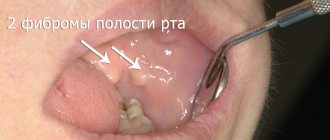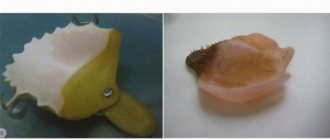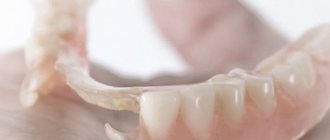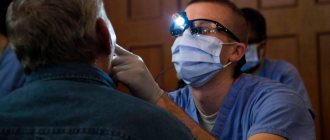Home|Facial malformations (cleft lip and palate)|Cleft palate (cleft palate)
Congenital defect of the hard and soft palate (cleft palate pathology) is a common facial malformation in infants. About a hundred babies are born every day in the world with this anomaly, most of whom are boys. It manifests itself as a rupture in the middle part connecting the oral cavity with the nasal cavity. Half of the children with this defect have a cleft lip defect. With timely treatment, cracks in the palate of a child are not dangerous to the life and health of the baby. The Towards Life project allows you to receive qualified medical assistance in correcting such defects free of charge.
Causes of cleft palate formation in humans
Experts do not have a consensus on the question of why children are born with a cleft palate. The appearance of the defect is associated with the presence of one or more provoking factors:
- inferiority of the germ cells of the parents: age over 40 years, hereditary gene mutations;
- infections and chronic diseases of the mother: rubella, chicken pox, herpes, syphilis, chlamydia, etc.;
- chemical intoxication: alcohol, drugs, smoking, chemicals, etc.;
- physical impact: amniotic fluid pressure, body overheating, radiation, falls, blows to the stomach, etc.
Often the cause of cleft palate is a metabolic disorder in the early stages of pregnancy, when it is accompanied by a lack of vitamins and minerals, toxicosis, lack of oxygen, and the threat of miscarriage. Taking antibiotics, sleeping pills and sedatives, medications for thyroid diseases, tumors, and arthritis can provoke a cleft palate in newborns. Psychological factors increase the risk of developing a defect: stress, prolonged experiences, lack of rest.
Types and manifestations of anomalies
The defect in newborns is manifested by a complete cleft of the soft and hard palate, passing through, or a small crack only in the soft tissues. According to the degree of bifurcation, the defect is classified into:
- complete – with splitting of soft and hard tissues up to the incisive foramen;
- incomplete - with a cleft only in the soft palate or with partial cleft of the hard palate;
- through – one- or two-sided clefts of the hard and soft palate with the inclusion of the alveolar process;
- hidden - the gap cuts only the muscles while preserving the oral mucosa.
“Cleft palate” in newborns, in addition to a cosmetic defect, is accompanied by a number of symptoms indicating disorders of the vital functions of the body. From the moment the baby is born, disturbances in sucking and swallowing of food appear. Shallow breathing develops, leading to oxygen deficiency and a tendency to inflammation of the middle ear, which negatively affects hearing. With the active growth of the baby, disorders of the speech apparatus (pronunciation of sounds through the nose) and delayed development of all body structures are detected.
Diagnosis of the defect
The intrauterine development of the fetal facial bones suggests their fusion at the 7-8th week of pregnancy. The formation of the oral and nasal cavities occurs in parallel. Disruption of these processes can become a turning point in normal development, causing abnormalities, and the cause of cleft palate in children. By 2 months, the embryo’s upper jaw is finally formed from halves growing towards each other. A delay in their fusion leads to a defect that is diagnosed in the womb.
A routine ultrasound examination reveals the defect at 14-16 weeks of pregnancy. The volume, shape of the lesion and the complexity of the disease can only be assessed after the baby is born. The diagnosis of “cleft palate” in a newborn child is clarified by examination of the pharynx and a number of additional studies. Their goal is to determine possible pathologies of skull development, breathing disorders, smell, hearing and sound production.
What should parents of a child with such an anomaly do?
The main thing is not to panic at the thought, my child has a cleft palate, and not to try to terminate the pregnancy. You shouldn’t risk the mother’s health by postponing the birth of a baby because of a defect that can be successfully treated with modern surgery. Abortion is too high a price, especially if the cause of the defect is hereditary, and it may appear during the next pregnancy. Timely surgical treatment of congenital cleft palate makes this anomaly safe for the life and health of children.
It is important to seek qualified medical help from specialists in time to correct the defect and prevent the development of numerous complications, including:
- respiratory failure leading to hypoxia (lack of oxygen);
- frequent infectious and colds that weaken the immune system;
- speech and hearing disorders;
- delayed growth and development of the jaw.
Gothic sky - what does it look like (symptoms)?
When this defect is detected, the hard palate is high, but at the same time narrow. The name comes from the shape, which is reminiscent of tall but slender Gothic buildings. People with this defect have trouble touching the tip of their tongue to the top of their mouth, which is often the main diagnostic test.
Due to the location of the palate within the oral cavity, diagnosis can be difficult, and diseases of the upper palate are often overlooked. In addition to differences in appearance between a healthy palate and a diseased palate, there may be differences in functioning, for example:
- Difficulty with the baby taking liquid food – breastfeeding can be significantly difficult due to problems with pressing the breast to the roof of the mouth and eating; with a gothic palate, you need to choose the right nipple;
- vicious swallowing, which is caused by the difficulty of raising the gothic tongue upward; the tongue remains displaced (this is called baby swallowing);
- poor respiratory tract - through the oral cavity, not the nasal cavity; this is seen as parted lips during the day and sleep with an open mouth;
- malocclusions – for example, crossbites or forehead defects;
- difficulty eating solid foods: biting, chewing, swallowing;
- speech defects – rhotacism (incorrect pronunciation of the letter “r”), lambdacism (incorrect pronunciation of the voice “l”), sigmatism (lisp).
About
How and where to treat a cleft palate?
Cleft palate surgery and cosmetic facial plastic surgery can eliminate external defects and restore the functionality of the oral and nasal cavities in a newborn (questionable, the operation is performed at the age of two years).
During the surgical operation, the palatine and pharyngeal muscles are connected in the correct position, the integrity, normal shape and functioning of all structures are restored. The extent of surgical interventions and the appropriate age for this are determined by the type of anomaly and the complexity of the case. After a thorough examination of the baby by the surgeon, one of the treatment tactics for children with cleft palate is selected:
- Uranoplasty (corrective surgery) from the age of 2 years – for incomplete clefts in children with regular upper jaw dentition.
- Uranoplasty at 4-6 years of age with preoperative orthodontic therapy - with a narrowed upper jaw and clefting, including the alveolar process.
- Two-stage correction (soft tissue plastic surgery with narrowing of the pharynx and, 6-8 months later, surgery on the hard palate with the alveolar process with simultaneous bone grafting).
Underdevelopment of the soft palate. Causes. Symptoms Diagnostics. Treatment
All iLive content is reviewed by medical experts to ensure it is as accurate and factual as possible.
We have strict sourcing guidelines and only link to reputable sites, academic research institutions and, where possible, proven medical studies. Please note that the numbers in parentheses ([1], [2], etc.) are clickable links to such studies.
If you believe that any of our content is inaccurate, out of date, or otherwise questionable, please select it and press Ctrl + Enter.
Underdevelopment of the soft palate owes its origin to a disruption in the development of the embryonic rudiments of the palatine plates, which can also lead to an anomaly in the development of the hard palate (Gothic vault of the oral cavity, underdevelopment of the posterior parts of the palatine plates). In this case, the posterior edge of the hard palate, to which the soft palate is attached, appears reduced in the form of an angle open posteriorly. This defect is masked by the soft palate, however, as a result of its underdevelopment, the nasopharynx remains open both during the phonation of nasal consonants and during the act of swallowing, which causes open nasal sound and the entry of liquid food into the nasopharynx. This defect also facilitates the penetration of foreign bodies from the oral cavity into the nasal part of the pharynx. The presence of an uncompensated defect of the soft palate requires a significantly higher consumption of pulmonary air necessary for phonation, therefore such patients take frequent pauses to inhale during a conversation. With such defects, removal of adenoids is contraindicated, since it leads to an increase in tubo-otitis and acute purulent otitis due to the more accessible entry of liquid food into the auditory tube.
Treatment of underdevelopment of the soft palate is difficult. The principle of treatment is to narrow the nasopharyngeal cavity, which in the past was achieved by injecting paraffin (vaseline) oil into the back of the pharynx. Later, various surgical methods were proposed to narrow this space, one of which is to mobilize the medial plate of the pterygoid process of the sphenoid bone with a pterygoid hook located at its end and bring it down. This process is identified by palpation directly behind and medially from the last upper molar, then a straight chisel is struck at its base. This manipulation achieves the mobilization of the muscles attached to this process, which by their own traction descend downwards and are located on the lower surface of the palatine aponeurosis, which leads to a certain narrowing of the nasopharynx. The operation is performed on both sides.
If this surgical intervention does not achieve the desired result, then they resort to pharyngoplasty, the essence of which is to cut out a rectangular flap of the mucous membrane from the posterior wall of the pharynx on the upper feeding pedicle, after which the posterior surface of the soft palate is refreshed and the lower one is fixed to it using several sutures. end of the flap, the rest of the flap is sutured to the back wall of the pharynx. Thus, the communication between the nasopharynx and oropharynx is divided into two cavities by a bridge formed from the mucous membrane of the posterior wall of the pharynx. On the sides of this bridge there are gaps that provide nasal breathing. After this operation, the patient must undergo a course of phoniatric speech therapy.
In case of partial insufficiency of the soft palate, reducing the space between the missing part and the posterior wall of the pharynx is possible by forming a similar flap on the upper pedicle opposite the defect of the soft palate and fixing it by turning it inward to form a bulge on the posterior wall of the pharynx and reduce the distance between it and the soft palate and provide functional obstruction of the nasopharynx during swallowing and phonation.
Stages of uranoplasty
Before surgery, your baby needs to learn how to feed from a spoon. Sucking after surgery for a cleft soft and hard palate in a child causes pain, impairs wound healing and scar formation. The correction is performed under general anesthesia due to the proximity of the airways and the need for complete immobility of the patient. If it is impossible to close the gap with local tissues, plastic surgery is performed with flaps taken from the cheeks or tongue. Repeated surgical interventions are possible no earlier than six months later, necessary to restore tissue and blood supply.
The operation for cleft of the hard and soft palate is carried out in several stages:
- The peeling away of plastic material on both sides of a gap to close the hole.
- Lengthening of soft tissues by cutting off the mucous membrane of the nasal cavity.
- Stitching the gap at the midline.
- Reducing the pharynx in the middle section by moving its lateral tissues to the middle.
- Step-by-step suturing (first on the nasal mucosa, then on the muscle tissue and oral mucosa) with treatment with an antiseptic solution.
- Attaching a plate that protects against infection.
Gothic palate in a child: causes of pathology, characteristic symptoms, methods of correction
Gothic palate is a pathology related to abnormalities in the development of the jaw and nasopharynx. The name is due to the shape of the palate, which is abnormally high (“arched”).
Gothic sky in a child - symptoms
Various types of microorganisms inhabit the human microflora, including pathogenic ones. Streptococcal infection is always present in the human body and its number is controlled by the immune system.
With reduced immunity, various types of bacteria begin to actively multiply, and their waste products cause diseases.
The respiratory, digestive, and genitourinary systems are mainly affected, but in advanced forms, colonies of streptococcal infections affect the heart, kidneys, and joints.
How is the infection transmitted?
- by airborne droplets;
- by food;
- by everyday means;
- sexually;
- fecal-oral route;
- by transplacental route (during childbirth);
- medically.
Many people have no idea how the disease caused by colonies of streptococcal infections is transmitted.
Airborne transmission is considered the most popular method of infection. Streptococcal infection is transmitted through coughing and sneezing. Public transport and unventilated public spaces are especially dangerous.
There is a chance of becoming infected through food, in particular, processed meat and dairy products, stale salads with mayonnaise, sweets with protein cream, burgers and sandwiches.
Staphylococcus can enter the body through contact with contaminated household items. Infection occurs through damaged mucous membranes of the mouth, nose or skin.
For example, through the use of towels, dishes, and bed linen of the patient. Drinking water in company from the same cup or from the neck of the same bottle is contagious.
If there is an infected person in a child’s social circle, his toy is dangerous for all the children around him.
It is possible to catch the infection through sexual intercourse, during intimate intimacy with an infected person. You can also become infected if you do not follow the rules of personal hygiene, so you need to wash your hands before eating.
At the birth of a child, a mother transfers her microflora to him, so before conception it is necessary to improve the body’s health.
Poorly processed medical instruments or instruments from beauty salons, piercings, and tattoos can cause infection.
Underdevelopment of the soft palate. Causes. Symptoms Diagnostics. Treatment
Underdevelopment of the soft palate owes its origin to a disruption in the development of the embryonic rudiments of the palatine plates, which can also lead to an anomaly in the development of the hard palate (Gothic vault of the oral cavity, underdevelopment of the posterior parts of the palatine plates).
In this case, the posterior edge of the hard palate, to which the soft palate is attached, appears reduced in the form of an angle open posteriorly.
This defect is masked by the soft palate, however, as a result of its underdevelopment, the nasopharynx remains open both during the phonation of nasal consonants and during the act of swallowing, which causes open nasal sound and the entry of liquid food into the nasopharynx. This defect also facilitates the penetration of foreign bodies from the oral cavity into the nasal part of the pharynx.
The presence of an uncompensated defect of the soft palate requires a significantly higher consumption of pulmonary air necessary for phonation, therefore such patients take frequent pauses to inhale during a conversation.
With such defects, removal of adenoids is contraindicated, since it leads to an increase in tubo-otitis and acute purulent otitis due to the more accessible entry of liquid food into the auditory tube.
Treatment of underdevelopment of the soft palate is difficult. The principle of treatment is to narrow the nasopharyngeal cavity, which in the past was achieved by injecting paraffin (vaseline) oil into the back of the pharynx.
Later, various surgical methods to narrow this space, one of which is to mobilize the medial plate of the pterygoid process of the sphenoid bone with a pterygoid hook located at its end and bring it down. This process is identified by palpation directly behind and medially from the last upper molar, then a straight chisel is struck at its base.
This manipulation achieves the mobilization of the muscles attached to this process, which by their own traction descend downwards and are located on the lower surface of the palatine aponeurosis, which leads to a certain narrowing of the nasopharynx. The operation is performed on both sides.
If this surgical intervention does not achieve the desired result, then resort to pharyngoplasty , the essence of which is to cut out a rectangular flap of the mucous membrane from the posterior wall of the pharynx on the upper feeding pedicle, after which the posterior surface of the soft palate is refreshed and the lower one is fixed to it using several sutures. end of the flap, the rest of the flap is sutured to the back wall of the pharynx.
Thus, the communication between the nasopharynx and oropharynx is divided into two cavities by a bridge formed from the mucous membrane of the posterior wall of the pharynx. On the sides of this bridge there are gaps that provide nasal breathing. After this operation, the patient must undergo a course of phoniatric speech therapy.
In case of partial insufficiency of the soft palate, reducing the space between the missing part and the posterior wall of the pharynx is possible by forming a similar flap on the upper pedicle opposite the defect of the soft palate and fixing it by turning it inward to form a bulge on the posterior wall of the pharynx and reduce the distance between it and the soft palate and provide functional obstruction of the nasopharynx during swallowing and phonation.
The child's palate is uneven
With this congenital pathology, the hard palate takes on a specific shape, slightly raising the teeth of the frontal group. The defect is partially compensated by the soft palate, but the nasopharynx remains constantly open.
This leads to various complications - from incorrect pronunciation of sounds (dysphonia), caused by a violation of the articular apparatus, to chronic diseases of the ENT organs and the entry of foreign bodies and liquids into the nasopharyngeal cavity.
Causes and consequences of the Gothic sky in a child
According to most experts, the cause of this anomaly is a violation of the formation of the palate rudiments at the embryonic stage (including underdevelopment of the palatine plates).
Among the main reasons are:
- genetic mutations;
- exposure to unfavorable exogenous factors on the body of a pregnant woman;
- traumatic injuries;
- intoxication;
- Rh conflict between mother and fetus;
- endocrinopathies in a pregnant woman;
- various diseases of viral origin.
Important: one of the predisposing factors in the development of the anomaly is the child’s mouth breathing.
The arched shape of the palate causes the formation of malocclusions, which leads to incorrect pronunciation of sounds.
Symptoms include difficulty pronouncing sibilant sounds and rhoticism (trouble pronouncing the “r” sound). Speech may be burry, and the pronunciation of “r” may be guttural. Problems with sigmatism and paparasigmatism (impaired pronunciation of hissing sounds) are caused by the fact that the tongue bends, going beyond the tubercles.
How to fix?
Correction is usually carried out through surgery, but complete clinical cure can not be achieved in 100% of cases. The optimal age for orthodontic correction is 5-6 years.
In some cases, it is possible to do without surgical intervention. Regular sessions with a speech therapist can often minimize or completely correct speech defects. A favorable environment and friendly attitude of others contribute to the correct development of pronunciation.
Plisov Vladimir, dentist, medical columnist
Rehabilitation period
The duration of postoperative rehabilitation is determined by the complexity of the case and the age of the patient.
If your child was born with a cleft palate, be prepared for the fact that his treatment will not be limited to surgery. The restoration of many functions depends on the quality of rehabilitation measures. In a hospital setting, they are aimed at improving the patient’s well-being, organizing proper nutrition, preventing disorders of the upper respiratory tract, and preventing infectious diseases and complications. In the future, the baby needs:
- additional treatment by an orthodontist for the correct relationship between the sizes of the dental arches and the development of the upper jaw;
- systematic observation by an otolaryngologist to monitor communication of the oral and nasal cavities, the functioning of the respiratory and hearing organs, and the prevention of ENT diseases;
- classes with a speech therapist to establish proper breathing, sound production, articulation, and correction of speech defects;
- consultation with a defectologist to identify possible developmental delays.
Gothic sky - what does it look like, can it be treated, with what device?
Gothic palate is an inherited condition that causes a variety of symptoms, including malocclusion or speech impediments, and difficulty feeding the child. What does such a defect look like? The hard palate is high and narrow (reminiscent of tall Gothic buildings). Treatment mainly involves tongue exercises. In advanced cases, a device or surgery is used (to expand the jaw in adults).
Fotolia
Help from the project “Towards Life”
The scope of rehabilitation activities, the number of doctors involved in the treatment, and the cost of cleft palate surgery in well-known medical centers should not diminish your determination to improve your child’s health. After consultation with specialists, you can do a significant part of the work to restore functions (breathing exercises, exercises to develop the speech apparatus, preventive measures, etc.) with your baby yourself at home. Your persistence and patience are an important component of success in treatment.
There is also an answer to the question of where surgery for congenital cleft palate is performed free of charge - in Yaroslavl. With the support of charitable organizations (Rusfond, “Beautiful Children in a Beautiful World”), we offer medical care from the best specialists without payment. To receive free surgical treatment from our maxillofacial surgeons: Doctor of Medical Sciences, Professor S.N. Bessonova and L.A. Eremeyshvili, you need to collect the necessary documents according to the list, send them for consideration and wait for the call for treatment.
You can make an appointment with a specialist by phone: 8 on weekdays from 9.00 to 19.00 Moscow time Or through the form on the website Sign up for a free consultation











